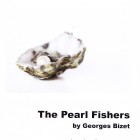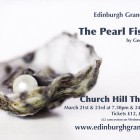Pearl Fishers 2018Edinburgh Grand Opera
Read more about the opera Pearl Fishers
Edinburgh Grand Opera have appointed Alistair Digges as their new Musical Director. His first production for the company is Bizet's Pearl Fishers. While far from being a perfect masterpiece, it is an enjoyable work with lots of memorable melodies to follow the great tenor-baritone duet 'Au fond du temple saint.' It can be an ideal work for amateur groups employing young professionals in the leading roles. There are some particularly enjoyable choruses and the exotic setting is usually well calculated to drive away the winter chill.
This enterprising staging, directed by Kally Lloyd-Jones, is generally successful in giving an effective presentation of the piece. Her note does emphasise the difficulty endemic in staging this example of mid-nineteenth-century exoticism. The 'minstrel show' connotations of white-skinned performers 'blacking-up' for stage performance is agreed to be unacceptable nowadays. The difficulty of finding an appropriate style of presentation - the concept - is not insurmountable however.
In tackling this issue head on, the director has decided to minimise the orientalism. Her emphasis lies in the idea that events could be located in a remote fishing community just about anywhere - not excluding our western isles or west coast of Ireland. Thus the colour palette of set and costumes is uniformly bleak and monochrome. A white-clad priestess contrasts with villagers in shades of charcoal, backed by a grey cloudscape, with a prevailing mist. Even the conflagration at the end adds little visual warmth. Nevertheless the staging is effectively directed.
The musical edition used relies on the reduced orchestration by Ken Roberts - string quintet, wind quartet and keyboard. It sometimes lacks body, but it is well-paced by Alistair Digges. The retention of Godard's traditional final trio, inserted soon after the composer's death to help get it performed, is not a problem in these circumstances. There have been recent attempts to return to something more authentic, but the jury still seems to be out.
Generally, the solo singing was thoroughly enjoyable. The most notable performance was that of the young baritone Arthur Bruce. Still training in Glasgow, he has a beautifully-schooled voice, easily produced throughout its range. He also has a keen sense of style and was completely relaxed with idiomatic projection of the French text. His career so far seems to have concentrated on concert work, which may explain his slight stiffness on stage, but that can be worked on. He certainly acted well during his last act appearances.
Catriona Clark is a more familiar performer, and she has developed into a beautifully warm-toned lyric soprano. She sang delightfully throughout the second and third acts. She was fractionally less-suited to the coloratura elements of her first appearances. Again, her French delivery was excellent. Roger Paterson started beautifully with his excellent contribution to the great duet. He didn't quite have the easy sweetness of tone for 'Je crois entendre encore', but hit form again later on. The ageless Ivor Klayman projected the priest's venom highly effectively.
In all this was a thoroughly enjoyable performance of a work that presents many challenges for the unwary. It should be noted that there are only three performances, and that the last one, at four pm on Saturday, is well-timed to attract punters from out of town.

